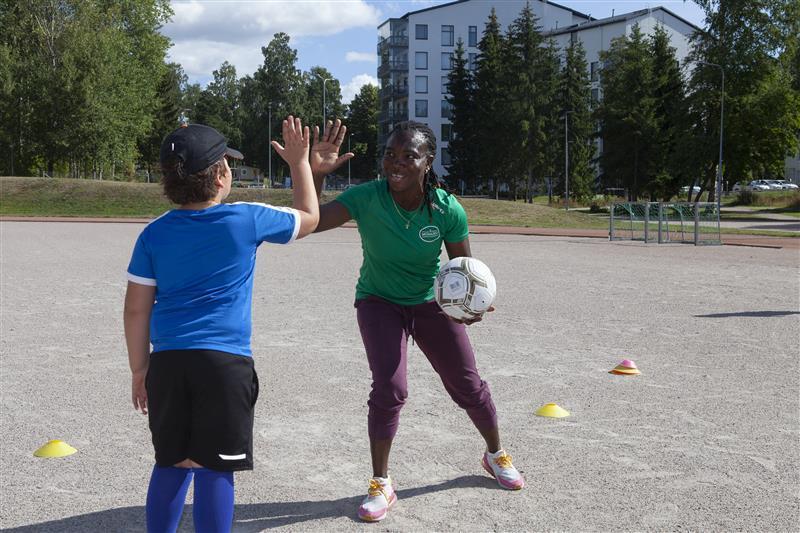It’s not always easy to detect everyday racism

Those of us not belonging to, say, language or cultural minorities don’t always detect actions that discriminate, hurt or maintain harmful stereotypes. Even behaving with good intentions doesn’t remove a person’s responsibility for their actions.
Let’s start with a little mental exercise. This mystery that I love makes my friends frustrated with their thinking one after another. This is how it goes:
A father and son were injured in a car accident and taken to different hospitals. When the son was taken to the operating room, the doctor said: “I can’t operate on him, he's my son.”
How is this possible?
Once you've solved the mystery, you can check the answer at the end of this blog post.
I think that the mystery, and especially my friends’ numerous solution suggestions from adoptive father to grandfather, demonstrate well why the current emphasis in racism-related discussion is on acknowledging and becoming aware of our normative thinking.
A norm refers to a typical image of some person. When we for instance visualise a teacher, what do they look like?
In my head, I immediately see an image of a white, slim, middle-class heterosexual woman with a bun on her head and no injury worse than eyeglasses. How many norms can you find in this image of mine?
This week is the week against racism. The theme this year is racism in working life. The “See, Say, Solve” campaign is encouraging individuals and organisations to acknowledge racism, to become aware of their prejudices and to take active action against racism.
Especially racism that targets the Roma and Sami populations is such a daily occurrence that discriminating practices have, at worst, even become a part of societal structures.
A young Roma person's career may already come to a halt during their studies, when they are unable to find a place for internship and the educational institution may even interrupt the young person's studies as a result. As for the failure of the Sami Parliament Act reform in February, it demonstrates that Finland is not complying with international agreements on the self-determination of indigenous people. Our history ranging from forced finlandisation of Sami people to mockery in the entertainment industry is a badge of shame for our country.
The discrimination of a young Roma person or denying the identity of Sami people are examples of the silent approval of many racist and discriminating practices. That is why it is not only extremely important but also challenging to acknowledge them and be aware of them.
Racist hate speech is just the tip of the iceberg. Most discrimination is subtle, and all of us are guilty of it.
Some weeks ago, I went to the pharmacy to pick up a prescription medication. I was served by an employee of whom I quickly assumed they wouldn’t be a native Finnish speaker. Almost without noticing it, I started to talk to them very clearly and slowly. When the person replied to me in completely normative spoken language that was lacking any foreign accent, I wanted the earth to swallow me. In a haste, I continued the conversation pretending that my weird manner of speaking had to do with some health issue. That’s even worse.
In my opinion, this is a good example of how racism and discrimination are often based on good intentions.
In working life, discrimination starts already when people are looking for work: Applicants whose name doesn't fit the norm are more rarely invited to interviews than others. According to the Finnish Red Cross, the most common forms of work discrimination are the attitudes of one's co-workers or supervisors, discrimination in career progression, and discrimination related to pay. Out of the share of the population that has experienced discrimination at work or when looking for a job, only 7% have informed about the matter.
Each of us has methods with which we can make working life more equal. First of all, it’s important to treat all co-workers equally instead of seeing some of them as representatives of their culture or “immigrant mascots”.
We must also be able to listen and hear when a co-worker talks about the discrimination or racism that they have experienced. Unfortunately, immigrants often report that their experiences are not taken seriously or that they are downplayed. "They meant well, don't take it to heart." Good intentions don’t eliminate the possibility of racist behaviour.
Nearly without exception, the challenges that immigrants have with finding a job are seen as resulting from their own shortcomings although, in reality, the structurally racist labour market is the largest hinder to finding a job.
Finland will be needing a lot of labour immigration in the future. We should all try to make Finland's equal working life the country's next business card that would make the country attractive to move into and stay in.
The mystery that I presented at the beginning of this post has been equally difficult to all my acquaintances, regardless of background. It reflects the fact that we all have prejudices, and there’s no need to be ashamed of them. Shame is a bad driver of change. It’s important to acknowledge and be aware of the norms of one’s thinking and to actively work to change them.
Change is already well under way. It occurred to me to ask my work partner to present the mystery to her 10-year-old daughter. She answered correctly without even thinking much about it. For her, the answer was obvious.
And then the real answer to the mystery. The doctor was the boy’s mother.